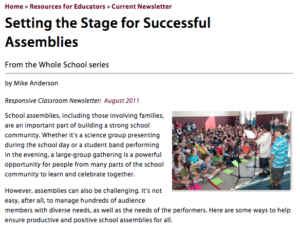Setting the Stage for Successful Assemblies
Original Article: http://www.responsiveclassroom.org/article/setting-stage-successful-assemblies
by Mike Anderson
School assemblies, including those involving families, are an important part of building a strong school community. Whether it’s a science group presenting during the school day or a student band performing in the evening, a large-group gathering is a powerful opportunity for people from many parts of the school community to learn and celebrate together.
However, assemblies can also be challenging. It’s not easy, after all, to manage hundreds of audience members with diverse needs, as well as the needs of the performers. Here are some ways to help ensure productive and positive school assemblies for all.
Support Audience Members
Begin by making sure the audience is comfortable so they can really engage in the performance. Too often, elementary school assemblies require students to sit on hard cafeteria or gym floors. It can be difficult to be attentive if your back, legs, and rear end hurt! Also, this arrangement often places older students and visitors in the back, where it’s hard to hear and see. Take the extra time to set up chairs, at least for those in the back. Consider scheduling two performances if that’s what it will take for everyone to sit comfortably and hear and see well.
Other strategies to ensure a positive audience experience:
- Model and practice assembly routines with students: At my school one year, students had a hard time following rules during assemblies. They’d enter the cafeteria pushing, jostling, and talking loudly. They often got out of control when applauding. To help them, we practiced all the expected behaviors with each grade level. Our principal modeled walking in and sitting quietly, applauding appropriately, and exiting quietly. What a difference that made!
- Get staff help: Staff members can model good audience skills, position themselves near wiggly students, and help the audience know when to applaud. Be sure to tell staff just what you want them to do.
- Communicate expectations to guests: Don’t assume that parents, other visitors, and school community members will know your expectations for assembly behavior. Is it okay for kids to be in the aisles? Must visiting children sit with their parents? Can parents videotape or snap photos? Reflect on what challenged audience members at previous performances. Then include some concise bullet points in your written notice about the event.
- Open with a reminder: To help everyone get on the same page, make a quick announcement about behavior expectations. A friendly and professional tone will put the audience at ease and encourage them to take the announcement seriously: “I know everyone is excited to hear our student band this afternoon. I want to remind you to focus on the performers, stay in your seat, and show your appreciation only by clapping. Let’s have a great concert!”
- Give positive feedback: At some point in the assembly, it’s helpful for the audience to hear what they’re doing well: “We’re really remembering to focus on the performers and applaud by clapping. We’re off to a great start, everyone—let’s keep it up!”
- If things aren’t going well, offer a reminder: “I’m hearing some people call out. Remember to show your appreciation only through clapping so that the performers can hear each other onstage.” This may feel a bit intrusive, but it’s better than allowing a few misbehaviors to snowball into something much bigger.
Support Student Performers
Student performers will naturally be nervous and excited about performing for peers and parents. There’s also a lot for them to remember. These strategies will help performers do their best:
- Model key behaviors and routines: Interactive modeling is a powerful yet simple strategy for helping students learn how to do all the things necessary for a performance: entering the assembly, finding your seat, waiting patiently while others perform, taking a bow, etc. Encourage all staff members to use this technique to model and practice expected behaviors with students.
- Post visual reminders: A simple sign can be a huge help. The adult leading the performers can simply point to a key word or symbol to help performers remember what to do.
- Intervene if needed: If a whole group is struggling to meet expectations, you might have everyone pause while you give a clear reminder: “Remember everyone, find the seat with your name on it.” If one or two children need help, give it as unobtrusively as possible. If a gesture or quick reminder isn’t enough, the performers may need to take a break from the assembly. Decide in advance where children will go and who will supervise them.
Assemblies Can Work for Everyone
Engaged and respectful audiences are a key—and often overlooked—element of successful school assemblies. When planning these events, we often think about supporting performers but forget to do the same for audiences. Taking the time to prepare everyone involved increases the likelihood that each assembly will serve the purpose of uniting the school community through a positive shared experience.





